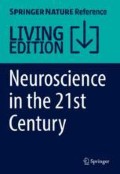Abstract
Positron emission tomography (PET), when coupled with molecularly targeted positron emitter labeled organic compounds or labeled drugs, enables the measurement of biochemical transformations and the movement of drugs directly into the human brain and other organs. PET is the only imaging technology that can image and quantify specific cellular elements as well as the distribution and movement of drugs in the living human brain. This chapter introduces PET technology and radiotracer chemistry, which has enabled the visualization and quantification of the chemical anatomy of the human brain (as well as that of other organs) while working within the time constraints imposed by short-lived isotopes. It concludes with examples of PET studies in major brain diseases and in drug development as well as an outlook for the future of PET technologies in the neurosciences including its value for understanding the role of genes in brain diseases.
References
Fowler JS, Ido T (2002) Initial and subsequent approach for the synthesis of 18FDG. Semin Nucl Med 32:6–12
Meyer JH, Wilson AA, Ginovart N et al., (2001) Occupancy of serotonin transporters by paroxetine and citalopram during treatment of depression: a [(11)C]DASB PET imaging study. Am J Psychiatry 158: 1843–1849
Special Issue (2013) Carbon-11 and fluorine-18 chemistry devoted to molecular probes for imaging the brain with PET. J Label Compd Radiopharm 56(3–4):65–262
Van de Bittner GC, Ricq EL, Hooker JM et al (2014) A philosophy for CNS radiotracer design. Acc Chem Res 47:3127–3134
Volkow ND, Wang GJ, Fowler JS et al (2011) Addiction: beyond dopamine reward circuitry. Proc Natl Acad Sci U S A 108:15037–15042
Wolkin A, Brodie JD, Barouche F, Rotrosen J, Wolf AP, Smith M, Fowler J, Cooper TB (1989) Dopamine receptor occupancy and plasma haloperidol levels. Arch Gen Psychiatry 46:482–484
Wong DF, Rosenberg PB, Zhou Y, Kumar A, Raymont V, Ravert HT, Dannals RF, Nandi A, Brasić JR, Ye W, Hilton J, Lyketsos C, Kung HF, Joshi AD, Skovronsky DM, Pontecorvo MJ (2010) In vivo imaging of amyloid deposition in Alzheimer disease using the radioligand 18F-AV-45 (florbetapir [corrected] F 18). J Nucl Med 51:913–920
Further Reading
Bergman J, Solin O (1997) Fluorine-18-labeled fluorine gas for synthesis of tracer molecules. Nucl Med Biol 24:677–683
Brooks DJ, Pavese N (2011) Imaging biomarkers in Parkinson’s disease. Prog Neurobiol 95:614–628
Fowler JS, Logan J, Shumay E et al (2015) Monoamine oxidase: radiotracer chemistry and human studies. J Label Compd Radiopharm 58:51–64
Jones T, Rabiner EA, PET Research Advisory Company (2012) The development, past achievements, and future directions of brain PET. J Cereb Blood Flow Metab 32:1426–1454
Kumar D, Mann JJ (2014) PET tracers for serotonin receptors and their applications. Cent Nerv Syst Agents Med Chem 14:96–112
Logan J (2003) A review of graphical methods for tracer studies and strategies to reduce bias. Nucl Med Biol 30:833–844
Mayberg HS, Liotti M, Brannan SK et al (1999) Reciprocal limbic-cortical function and negative mood: converging PET findings in depression and normal sadness. Am J Psychiatry 156:675–682
Miller PW, Long NJ, Vilar R et al (2008) Synthesis of 11C, 18F, 15O, and 13N radiolabels for positron emission tomography. Angew Chem Int Ed Engl 47:8998–9033
Nord M, Farde L (2011) Antipsychotic occupancy of dopamine receptors in schizophrenia. CNS Neurosci Ther 17:97–103
Nutt R (2002) 1999 ICP Distinguished Scientist Award. The history of positron emission tomography. Mol Imaging Biol 4:11–26
Rotstein BH, Liang SH, Holland JP et al (2013) 11CO2 fixation: a renaissance in PET radiochemistry. Chem Commun (Camb) 49:5621–5629
Schroeder FA, Wang C, Van de Bittner GC (2014) PET imaging demonstrates histone deacetylase target engagement and clarifies brain penetrance of known and novel small molecule inhibitors in rat. ACS Chem Neurosci 5:1055–1062
Seo YJ, Kang Y, Muench L et al (2014) Image-guided synthesis reveals potent blood-brain barrier permeable histone deacetylase inhibitors. ACS Chem Neurosci 5:588–596
Stoessl AJ, Brooks DJ, Eidelberg D (2011) Milestones in neuroimaging. Mov Disord 26:868–878
Wong DF, Tauscher J, Grunder G (2009) The role of imaging in proof of concept for CNS drug discovery and development. Neuropsychopharmacology 34:187–203
Zhu L, Ploessl K, Kung HF (2014) PET/SPECT imaging agents for neurodegenerative diseases. Chem Soc Rev 43:6683–6691
Author information
Authors and Affiliations
Corresponding author
Editor information
Editors and Affiliations
Rights and permissions
Copyright information
© 2016 Springer Science+Business Media New York (outside of USA)
About this entry
Cite this entry
Fowler, J.S., Volkow, N.D. (2016). Molecular Imaging: Positron Emission Tomography. In: Pfaff, D., Volkow, N. (eds) Neuroscience in the 21st Century. Springer, New York, NY. https://doi.org/10.1007/978-1-4614-6434-1_149-2
Download citation
DOI: https://doi.org/10.1007/978-1-4614-6434-1_149-2
Received:
Accepted:
Published:
Publisher Name: Springer, New York, NY
Online ISBN: 978-1-4614-6434-1
eBook Packages: Springer Reference Biomedicine and Life SciencesReference Module Biomedical and Life Sciences
Publish with us
Chapter history
-
Latest
Molecular Imaging: Positron Emission Tomography- Published:
- 30 July 2016
DOI: https://doi.org/10.1007/978-1-4614-6434-1_149-2
-
Original
Molecular Imaging: PET- Published:
- 14 March 2016
DOI: https://doi.org/10.1007/978-1-4614-6434-1_149-1

